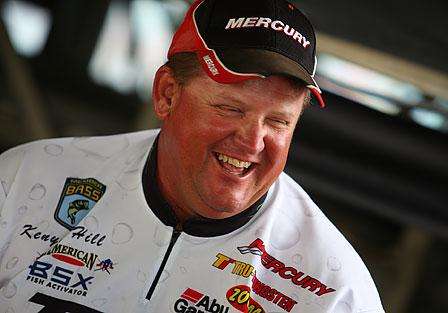
Kenyon Hill is a B.A.S.S. millionaire, a three-time B.A.S.S. winner and four-time Bassmaster Classic qualifier. In the fall, he catches bass that others miss by targeting the places that usually don't get much attention. You can do it, too.
Season
Fall
Water Conditions
Water temperature: Around 65 degrees.
Water color: Stained to clear. If the water's too clear, the bass can be spooky.
Wind/current: Not a major factor, but too much wind can muddy the water and cause the bass to move out off the shallow flats.
Structure/Cover
Structure: Shallow, flat pockets with a sandy or muddy bottom. The bass are here because the shad are here.
Cover: Stumps, old tires, logs, almost anything.
Depth: 0-2 feet.
Tackle
Lures: (1) A shad-patterned topwater popper like the Rebel Pop-R or Don Iovino's Splash-It, (2) a shallow-running shad imitation crankbait like the Luck E Strike Rick Clunn Square Bill crankbait or (3) a Zoom Magnum Finesse Worm in watermelon or watermelon red fished Texas style with a 1/8- or 3/16-ounce slip sinker.
Rod: Hill prefers a 7-foot medium action casting rod for the popper and crankbait and a 7-foot medium-heavy model for the worm.
Reel: Baitcasting reel with about a 6:1 gear ratio. Hill believes that faster reels, like 7:1 models, can lack power while a 5:1 gear ratio is too slow for this run-and-gun pattern.
Line: For the popper or crankbait, Hill opts for 14-pound-test monofilament. For the worm, he likes 14- to 17-pound-test fluorocarbon.
Presentation
Cast/Flip/Pitch: Casts will range from long to short with the plugs, and Hill could be flipping, pitching or casting the worm.
Retrieve: Hill likes to keep the popper moving with quick, soft "spits" instead of louder pops. He works the crankbait with a medium to fast retrieve in search of a reaction bite. With the worm, he's typically making multiple casts to cover in hopes of luring a lethargic fish out of a brushpile or other obstruction.
Keys to Success
This is one time of year and one pattern where boring is good. If Hill sees lots of cover or evidence of fishing pressure in a pocket, he typically ignores it. If, however, the pocket looks dull and uninteresting but has pods of shad in it, he knows he's found an area with real (and likely untapped) potential. He likes to run his Hydrowave Underwater Feeding Simulator on a low setting to help stimulate bass activity. Otherwise, this is a good time to be quiet and stealthy; since the water's shallow, the fish are apt to be skittish.





